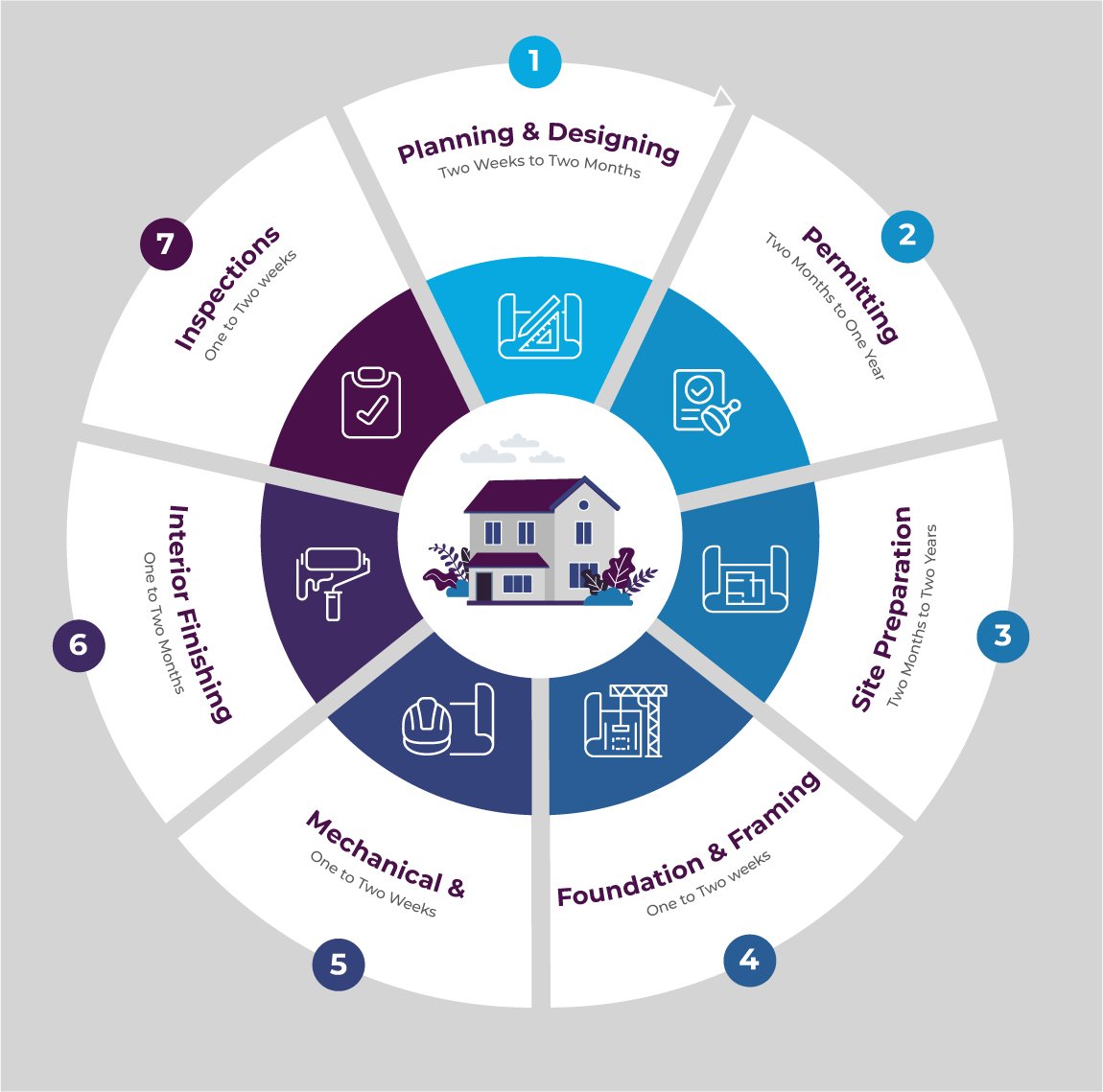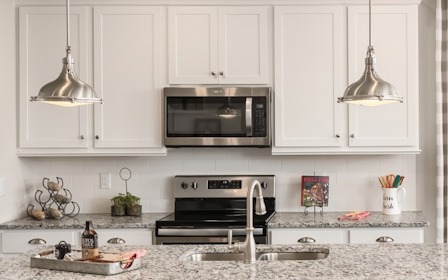When buying a home, one of the best ways to ensure you get the house of your dreams is to buy a new construction property. In many cases, new homes are more affordable, easier to buy (no haggling), and cheaper to insure than pre-owned homes. But you may be wondering, what is the new construction homebuying process, and how long does the homebuilding process take? These elements are important if you're buying a home that hasn't been built yet.
Keep reading to gain an understanding of the new home-building timeline!
Factors That Affect the New Home Construction Process Timeline
Typically, the new home construction process consists of planning, site preparation, construction, and adding the finishing touches. However, multiple factors can delay (or quicken) this time frame. The most common factors that can affect homebuilding include the following.
Home Size and Complexity
As you might imagine, building a multi-story home is more complicated and takes longer than building a one-story structure. Similarly, the more rooms and add-ons a home has, the longer it takes to construct.
However, it's not just the number of rooms that affect the complexity of the construction process. For example, bedrooms and living rooms are easier to build because they require less infrastructure (beyond electricity). However, bathrooms and kitchens can take more time because they need plumbing and electricity, along with ductwork, backsplashes, and storage space.
Site and Location
The location of a new house affects multiple parts of the new construction homebuilding process. For example, some states have different regulations, such as zoning and building codes. So, crews must abide by these rules before they can break ground or start working on the foundations. Other factors can include:
- Transportation—When homes are in a residential district, it's relatively easy to bring trucks, crews, and materials to the job site. However, if a house is in a remote location with fewer roads (or more natural obstructions), the time frame extends accordingly. In some cases, crews may have to clear a site of trees, rocks, and other features before they can mark the foundation.
- Nearby Structures—One advantage of building in a relatively remote area is that crews don't have to worry about disrupting neighbors or local businesses. So, if a new house is going up in a residential district, workers have to consider noise complaints and potential contamination of chemicals or waste byproducts.
- New Development—In many cases, new construction homes are built as part of a community. When this happens, it's much faster to get everything done because crews can build multiple homes at once and not worry as much about neighbors or transportation.
Material Availability
Different parts of the country are easier to build in than others. For example, Hawaii is the most expensive state to build new homes in, as it costs an average of $205 per square foot. Massachusetts is also pretty expensive, at $192 per square foot.
By comparison, Mississippi and Arkansas are the cheapest states in which to build, with an average cost of $137 per square foot. That said, the type of home also matters. For example, a wooden house is often more affordable than a similar structure made from bricks, metal, or concrete. Also, as we mentioned, larger houses will cost more because they require more materials, and depending on the area, high demand could cause shipping and transportation delays.
Weather Conditions
Building in inclement weather doesn't work because rain, sleet, and snow can cause unnecessary wear and tear or damage interior components. However, once the roof is in place, workers can still handle interior spaces when it's raining.
That said, stronger weather systems can also cause delays. For example, high winds can blow structures down or cause partial damage to the home. Also, if you're building in an area with natural disasters, they can destroy part or all of the building.
The 7 Stages of Building a Home
Building a house is a lengthy and multi-step process, and each stage can take a while to complete, depending on the situation. Even if everything else is going according to plan, something could still delay construction and make it harder to finish on time. Here's an overview of the new home construction process timeline.

Planning and Design
During this phase, architects come up with the design of the house, including dimensions, features, and even the materials needed for the project. This phase may include various experts to provide insight into everything from which materials will work best (or can be sourced easily) and whether a proposed design will work or not.
Overall, this stage can take anywhere from a couple of weeks to a few months, depending on the complexity of the project. If the home is part of a planned community, the planning stage usually encompasses multiple home designs and layouts.
Permitting
Before construction can begin, the home builders must get permits from state and local regulators. These permits can include a standard building permit, well or septic permits, and road cut permits (for driveways or neighborhood roads). However, some municipalities may have other specific permits, and each city and county enforces its own building codes and regulations.
Sometimes, permitting can be relatively straightforward, but it also requires approval and inspection to ensure the building meets the required standards. Overall, this process can take a couple of months or up to a year, depending on how quickly the permitting entities act. Also, if there are any special considerations for a home (e.g. solar energy, LEED certification, etc.), the permitting stage can take even longer.
Site Preparation
Some sites are ready for homes, meaning they're level and have plumbing access ready to go. However, if the site isn't ready, the construction crew has to prepare it. This process can include elements like:
- Surveying—Studying the plot to determine how much work is necessary to make it ready for building.
- Grading—This step involves making the land flat so builders can lay the foundation.
- Leveling—This is part of the grading process, and it ensures each section is as flat and level as possible.
- Clearing—Even if a section of the plot won't have a structure on it, the crew may need to clear out trees, rocks, and other natural elements.
- Drainage—Homes need to connect to the main water system and have a way to drain rainwater. Drainage lines and pipes are dug during this stage.
- Earthmoving—Grading, clearing, and leveling often involve moving a lot of earth. Crews need machinery and a way to remove waste.
Each site requires different work, so this stage could take a couple of months or a couple of years, depending on the site and how easy it is to prepare.
Foundation and Framing
The foundation of a home is the most critical part because it will determine the strength and longevity of the property. If the foundation is unstable or the crew puts the wrong kind of foundation, they may have to tear everything up and start over.
The most common types of home foundations include:
- Concrete Slab—Many homes use a slab foundation, which involves pouring four to eight inches of concrete on the site. This option is simple and affordable but can make it hard to access the drainage and piping lines underneath the slab.
- Crawlspace—Homes in hot and humid environments tend to use crawl spaces to prevent moisture and mold from building up in the foundation. Crawlspaces are often not heated, but open to allow for air to flow through. Encapsulation helps protect the foundation and keep pests and moisture out.
Concrete foundations can take between two and four weeks to set correctly. If the timeline is rushed, the concrete may be more susceptible to cracks and damage over time.
Mechanicals and Insulation
Once the main structure of the home is finished, crews must install various mechanical systems, such as electrical panels and wiring, plumbing, HVAC systems, and more. Once these pieces are in place, workers will put insulation around them to keep the interior temperature regulated throughout the year.
This stage doesn't take very long (a week or two), but more complex houses will need a few extra weeks to get everything in place and working correctly.
Interior Finishing
The final stage of home construction involves putting in the finishing touches for the interior. These touches can include walls, surface materials (e.g. wallpaper), and built-in fixtures like lights, shelves, and flooring. During this stage, the crew may also install exterior finishes like siding and brick facades.
This stage can take up to one to two months or more, depending on how the builders want the home to look.
Inspections
Once the house is built, it needs to be inspected to ensure that everything complies with local regulations and building codes. These inspections are also designed to ensure the final design and construction match what was proposed during the initial phases.
The inspection itself only takes a few hours, but it could take a few weeks to schedule and confirm the inspection date.
Build Time Depends on a Variety of Factors
As you can see, the build process timeline can take as little as six months or take as long as a few years if the building process is continually delayed due to permitting issues, weather conditions, and material availability. With so many variables to consider, getting an exact date when construction finishes is virtually impossible.
Fortunately, when asking, "How long after closing can you move into new construction?" The answer is almost always "immediately." Because the builder is the seller, you don't have to wait for the seller to move out. Instead, you can get the keys once the certificate of occupancy is approved.
Now that you know how long after closing can you move into newly built homes, you may be itching to buy one. Fortunately, at Century Communities, we have a wide selection of properties around the country. Don't miss out on the opportunity to experience the convenience of a brand-new home.
Start your journey to a beautiful new home today with us!


